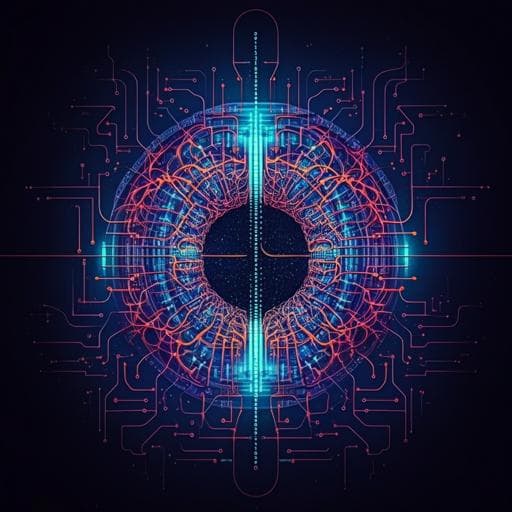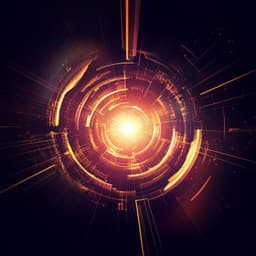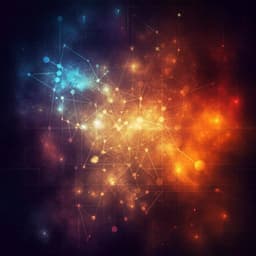
Physics
Demonstration of a superconducting diode-with-memory, operational at zero magnetic field with switchable nonreciprocity
T. Golod and V. M. Krasnov
Discover groundbreaking prototypes of superconducting diodes that operate at zero magnetic field, developed by Taras Golod and Vladimir M. Krasnov. These innovative diodes demonstrate nonreciprocity and exceptional rectification efficiency, paving the way for future in-memory superconducting computers!
~3 min • Beginner • English
Introduction
The study addresses the need for energy-efficient, high-speed computing components suitable for cryogenic, superconducting electronics. Superconductors eliminate resistive losses (R = 0) and allow operation frequencies set by the superconducting gap, potentially in the terahertz range, which could far exceed modern semiconductor electronics. A key component is a diode exhibiting nonreciprocal current-voltage characteristics for rectification and logic. However, achieving nonreciprocity at zero magnetic field (H = 0) is challenging because time-reversal symmetry enforces reciprocity unless both space and time-reversal symmetries are broken. Prior spatially asymmetric superconducting devices and Josephson ratchets require finite magnetic fields, making them unsuitable for zero-field operation. The research question is whether one can realize a superconducting diode that operates at zero magnetic field with large, switchable nonreciprocity and added memory functionality, using conventional superconducting materials and device architectures. The authors propose combining self-field effects from intentionally nonuniform biasing with persistent stray fields from a trapped Abrikosov vortex to break the required symmetries and shift nonreciprocity to zero field, enabling a superconducting diode-with-memory.
Literature Review
Earlier work showed that spatial asymmetry in Josephson junctions (e.g., nonuniform critical current density or bias) can yield nonreciprocity but only at finite magnetic fields. Superconducting ratchet devices have rectified motion of Josephson or Abrikosov vortices but similarly require magnetic fields. Recent interest has focused on noncentrosymmetric superconductors and heterostructures where spin-orbit interaction induces nonreciprocal transport either near Tc (resistance asymmetry) or at low temperature (supercurrent rectification). Some reports claim zero-field superconducting diode effects in van der Waals heterostructures and graphene systems, often requiring additional mechanisms. Thus, while multiple routes to diode-like behavior exist, robust zero-field operation in conventional materials remains scarce. This work builds on classical nonuniform JJ concepts and vortex-induced phase/flux shifts, employing trapped Abrikosov vortices to provide a flux offset that shifts strong nonreciprocity, otherwise located at finite fields, to zero field in standard Nb-based planar junctions.
Methodology
Concept and modeling: The authors consider short Josephson junctions (length L < λJ), minimizing screening and Josephson vortex effects. Zero-field diode action requires breaking space/time symmetry. Two ingredients are combined: (i) a nonuniform bias current and/or critical current density J(x) to induce self-field effects and nonreciprocity at finite H; (ii) persistent stray fields from a trapped Abrikosov vortex (AV) placed near the junction to offset the Fraunhofer pattern, shifting the nonreciprocity to H = 0. Numerical simulations compute the critical current by maximizing ∫ J(x) sin[φ(x)+φ0] dx with respect to φ0, with φ(x) = 2π deff By x + φv(x), By = H + Lφ I / A (self-field), and φv(x) = −V arctan(x/ξ) from the vortex (V is vorticity). Parameters Lφ, V, and a nonuniform J(x) profile (e.g., V-shaped with ~25% reduction at x = L/2) are used for fitting.
Device design and fabrication: Two four-terminal, cross-like planar devices were made: D1 (Nb/CuNi bilayer: Nb 70 nm top, CuNi 50 nm bottom; proximity-coupled Nb–CuNi–Nb JJs) and D2 (single Nb 70 nm; Nb-c-Nb variable-thickness constriction JJs). Films were DC-sputtered, patterned into ~6 μm wide bridges by photolithography and reactive ion etching, and nanopatterned by Ga focused ion beam (FIB) to form JJs (20–30 nm groove in top Nb) and a vortex trap (≈50 nm diameter hole) located at xv = L/2, zv ≈ 0.1 L from JJ1. Junction length L ≈ 5.6 μm. Nb-c-Nb junctions (D2) exhibit larger IcRn (approaching ~1 mV at low T), enhancing readout voltage and frequency f ≈ IcRn/Φ0.
Bias configurations and self-field control: The cross geometry provides four electrodes (left, right, top, bottom). Three bias configurations were used: straight (bottom-to-top) and over left/right corners. Straight bias produces no Hx self-field component, whereas corner biases induce positive/negative Hx, tilting Ic(H) (Fraunhofer) patterns in opposite directions and enabling controlled spatial asymmetry.
Vortex control: Abrikosov vortices/antivortices are trapped in or removed from the engineered hole using short current pulses. Their stray fields provide a tunable flux offset determined by the vortex polar angle relative to the junction, effectively shifting nonreciprocity peaks toward H = 0 when positioned optimally (e.g., zv ~ 0.05 L).
Measurements: Experiments were carried out in a closed-cycle cryostat with magnetic field applied perpendicular to the film (y-direction). Ic(H) patterns were recorded by sweeping H via a superconducting solenoid and using a small voltage criterion (Vth ≈ 1–2 μV) on nonhysteretic I–V curves. Rectification was evaluated under AC bias Iac with frequency (e.g., 23 Hz) by time-averaging the voltage. The ideal maximum rectified voltage for a fully asymmetric I–V is Vmax = Iac Rn / π. Numerical fits used the self-field inductance Lφ, vorticity V (flux offset), and J(x) nonuniformity to reproduce experimental Ic(H) patterns, including cases without and with vortex/antivortex (typical fitted flux offset Φ/Φ0 ≈ ±0.47).
Key Findings
- Nonuniform bias in cross-like JJs creates strong self-field-induced nonreciprocity at finite magnetic fields: in vortex-free devices, Ic(H) patterns tilt under left/right corner bias, producing nonreciprocity factors up to ≥10 at fields around |H| ≈ 0.8 Oe.
- Trapped Abrikosov vortices/antivortices shift and distort Ic(H) without themselves inducing nonreciprocity; when combined with bias nonuniformity, they shift the large nonreciprocity peak to H = 0. Numerical modeling shows the nonreciprocal peak moves from Φ/Φ0 ≈ 1 toward 0 as the vortex approaches the junction (optimal around zv ~ 0.05 L), enabling zero-field operation.
- Experimental zero-field superconducting diode operation: With an AV or an antivortex trapped near the junction, significant nonreciprocity at H = 0 is observed. Reported zero-field nonreciprocity factors exceed 3–4 for both junctions on device D1, with slight field offsets (~0.1 Oe) depending on geometry.
- Switchable polarity and on/off functionality: Diode polarity reverses between vortex and antivortex states (Ic(+) > Ic(−) for vortex; Ic(+) < Ic(−) for antivortex). Polarity also flips by switching between left/right corner bias configurations (which invert the self-field sign). Nonreciprocity can be switched on/off by trapping/removing a vortex. This enables three persistent memory states at H = 0: “0” (no vortex; reciprocal), “+1” and “−1” (vortex/antivortex with opposite polarities).
- Rectification: Rectified DC voltages under AC bias exhibit central peaks. Idealized simulations (nonreciprocities ~30–50) show near-ideal rectification (Vdc → Vmax = Iac Rn / π). Experimentally, vortex-free central peaks exceed ~80% of Vmax; with vortex/antivortex at H = 0, peaks exceed ~70% of Vmax, indicating high rectification efficiency.
- Materials/platform comparison: Nb-c-Nb constriction JJs (D2) have larger IcRn (~1 mV at low T), yielding proportionally larger rectified voltages and higher potential operating frequencies f = IcRn / Φ0 than Nb–CuNi–Nb (D1), while both devices display similar diode behavior.
- Flux offset from trapped vortex: Fits to Ic(H) with vortex/antivortex yield Φ/Φ0 ≈ ±0.47, consistent with expected azimuthal phase contributions.
- Overall performance: Nonreciprocity at H = 0 exceeds a factor of 4; at finite fields, more than an order of magnitude. Rectification efficiencies reach >70% at H = 0 and >80% near optimal finite fields.
Discussion
The work demonstrates a practical route to zero-field superconducting diodes by combining engineered bias nonuniformity (to break spatial symmetry and generate self-fields) with persistent stray fields from a controllably trapped Abrikosov vortex (to shift the nonreciprocal response to H = 0). This approach addresses the fundamental time-reversal constraint at zero field by effectively offsetting the Fraunhofer pattern via the vortex-induced phase/flux, while maintaining a strong bias-induced nonreciprocity. The measured performance—zero-field nonreciprocity factors ≥3–4 and rectification efficiencies ≥70%—is sufficient for basic rectification and logic functions in superconducting electronics. The ability to switch on/off nonreciprocity and invert polarity via either vortex sign or bias configuration directly enables in-memory functionality with multiple nonvolatile states, mitigating data-movement bottlenecks in computation. Using conventional Nb technology and simple planar, non-SQUID geometries facilitates scalability and integration. Numerical modeling suggests further optimization (e.g., tailored J(x), precise vortex placement) could enhance nonreciprocity by another order of magnitude, pointing to substantial headroom for device improvement and application in superconducting in-memory computing architectures.
Conclusion
The authors have realized superconducting diodes-with-memory that operate at zero magnetic field using conventional Nb planar Josephson junctions. By combining nonuniform bias to induce strong nonreciprocity with stray fields from a trapped Abrikosov vortex to shift this effect to zero field, they achieve switchable, high-efficiency rectification and polarity control. Experiments show zero-field nonreciprocity factors ≥3–4, more than an order of magnitude at finite fields, and rectification efficiencies ≥70% at H = 0. The polarity and presence of nonreciprocity can be toggled by vortex trapping/removal and by changing bias configuration, enabling three-state nonvolatile memory at zero field. Given the mature Nb technology and compact geometry, this approach is promising for superconducting in-memory computing. Future work should optimize junction inhomogeneity and vortex placement to further boost nonreciprocity and efficiency, explore higher-frequency operation leveraging large IcRn (especially in Nb-c-Nb junctions), and integrate arrays for complex logic and memory functions.
Limitations
The paper does not present a dedicated limitations section. From the reported results: (i) the experimentally demonstrated zero-field nonreciprocity (≈3–4) is smaller than the best finite-field values (≥10), with authors noting that careful design could improve performance by another order of magnitude; (ii) optimal operation requires precise control of bias asymmetry and vortex/antivortex trapping position to achieve the desired flux offset near H = 0; (iii) simulations assume short junctions (L < λJ) and neglect screening, which may limit direct applicability to longer junctions where Josephson vortices affect symmetry; (iv) performance metrics and demonstrations are shown on two device implementations (Nb–CuNi–Nb and Nb-c-Nb), and broader scalability/integration aspects are left for future work.
Related Publications
Explore these studies to deepen your understanding of the subject.







